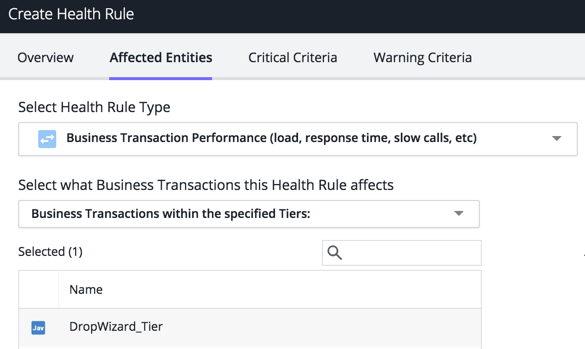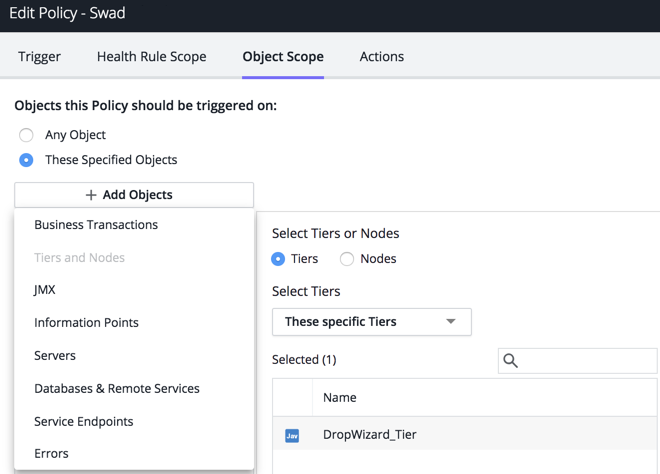Download PDF
Download page Health Rule Entities.
Health Rule Entities
This page provides an overview of health rule entities in AppDynamics.
A health rule can evaluate metrics associated with an entire application or a limited set of entities. For example, you can create business transaction performance health rules that evaluate certain metrics for all Business Transactions in the application or node health rules that cover all the nodes in the application or all the nodes in specified tiers. The default health rules are in this category.
You can also create health rules that are applied to a limited set of entities in the application, or even a single entity such as a node or a JMX object or an error. For example, you can create a JMX health rule that evaluates the initial pool size and number of active connections for specific connection pools in nodes that share certain system properties.
Monitoring Serverless Entities
Serverless functions are tracked at the tier level. A serverless function is indicated by a lambda (λ) icon inside each tier. When you configure a health rule for an application comprising serverless entities, you can choose to monitor the serverless tiers in the Affected Entities tab. For information on how various health rules are evaluated for serverless entities comprising tiers for AWS Lambda, see Evaluating Serverless Tiers.
The health rule wizard lets you specify which entities the health rule affects, enabling the creation of very specific health rules. For example, for a Business Transaction, you can limit the tiers that the health rule applies to, or limit the health rule application to specific business transactions by name or by names that match certain criteria.

For node health rules, you can specify the type of the node, such as Java, .NET, PHP, and so on.
You can specify that a health rule applies only to nodes that meet certain criteria.

The Type of Node pulldown menu does not allow you to specify Node.js, Python, or Web Service nodes. To restrict a health rule to these types of nodes, you can specify the affected entity as a tier and then select only Node.js or Python or Web Service tiers as needed. Or to more finely-tune the affected nodes, use the Nodes matching the following criteria menu item to specify node names or matching environment variables or meta-info to restrict the health rule to the nodes you want.
Entities Affected by a Health Rule
For an Overall Application Performance Health Rule type, the health rule applies to the entire application, regardless of the business transaction, tier, or node.
If you configure your Health Rule to work with tiers, you must also configure the parallel policy to work with tiers. However, if you configure your Health Rule to work with tiers, but your policy is configured with nodes first, you will not trigger any actions or notifications. The inverse is also true. The following screenshots show examples of a health rule and a policy created in the correct order.


The following table lists the entities that you can apply health rules to.
| Health Rule Type | Applicable Entities |
|---|---|
| Business Transaction Performance |
|
| Custom |
|
| Databases & Remote Services health |
|
| Error Rates |
|
| Information Points |
|
| Node Health—JMX |
|
| Node Health—Transaction Performance or Node Health—Hardware, JVM, CLR |
The performance of serverless tiers is not evaluated for Tier/Node Health (Hardware) health rules. AWS does not offer node-level dashboards or metrics because the serverless platform runtime instances spin up and down on demand. |
| Server health |
|
| Service Endpoint |
|
| User Experience - Mobile Apps |
|
| User Experience - Mobile Network Requests |
|
| User Experience - Browser Apps—Pages, iframes, Ajax Requests, Virtual Pages, Synthetic jobs |
|